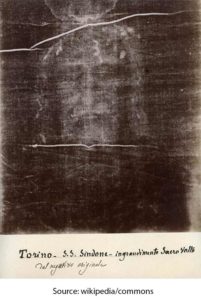The sign of Jonah – or a whale of a tale
Over the years I have been keeping reasonably up to date on the findings and theories concerning the shroud of Turin. Every year something new emerges as various scientists seek to understand this enigmatic burial shroud.
The shroud put in its first recorded appearance in 1356 at a time when religious relics and superstitions were rife in medieval Europe. Some researchers claim to be able to trace it back to the sixth century and one even claims that there is reasonable evidence for it coming out of the first century. Whatever its recorded history, many religious people think it is the authentic burial cloth of the Lord Jesus Christ. Recently the Pope went to pray before the shroud, so clearly he believes it has significance.
No matter what one thinks of the shroud, it certainly is a mystery. In 1898 it was photographed for the first time and this led to an intriguing discovery: the image in the shroud is a negative. Up to this time most sceptics thought that the image was simply the work of a skilled medieval artist trying to cash in on the relics market. However, the discovery that the image was actually a negative put this idea under a lot of pressure. Recently artists and scientists have attempted to reproduce such an image using pigments, dyes, rubs, heat treatments and so on. Their results are interesting but far from compelling. Besides, current microscopic examination of the fabric shows no evidence at all of any pigments.
 In 1988 carbon 14 dating indicated that the shroud originated in the middle ages. More recently, however, facts have immerged which prove that the process was seriously flawed and that the cloth could well date back to the first century.
In 1988 carbon 14 dating indicated that the shroud originated in the middle ages. More recently, however, facts have immerged which prove that the process was seriously flawed and that the cloth could well date back to the first century.
Since 2003 a number of articles have appeared in reputable scientific journals seeking to make sense of the shroud and its image. A popular hypothesis is that the image was formed by ammonia derivatives from a human body interacting with carbohydrate residue in the fabric (the Maillard reaction). But this doesn’t fully explain the remarkable image. It seems that the image in the shroud is a sort of 3D terrain map of the body it covered. Because of this quality, researchers have been able to use modern computer techniques to develop a full reproduction of the body. In 2010 the History channel aired a documentary showing the results of this process. The resultant 3D image shows a man with abrasions in his face, shoulder, and knees. The scourge marks of a cat-o-nine tails are visible and the wound in the side, wrists and feet are unmistakable.
The consensus opinion at this time is that the shroud of Turin is genuine in that it carries within its fibres the image of a man who died by crucifixion and that in all probability the material can be dated back far earlier than the medieval era. Is it the burial shroud of Jesus? No one can be sure of this, but it is true that the wounds shown in the image conform to the Gospel record of the crucifixion.
Some scientists are still not satisfied with the chemical interaction theory of how the image was formed. They claim that a catalytic event must have caused such a reaction. They theorise that some form of energy must have passed through the fabric to trigger a chemical reaction. One hypothesis is that the units of matter called nuceons must have decoupled causing a dematerialisation of the body. Simply put, the body passed through the fabric of the shroud.
All this is interesting but far from conclusive, so why am I interested in it, and why should you be? Luke 11 and Matthew 16 record Jesus’ words concerning the only sign He was prepared to give an unbelieving generation. Matthew 12:38-41 records, ‘Then some of the Pharisees and teachers of the law said to him, “Teacher, we want to see a miraculous sign from you.” He answered, “A wicked and adulterous generation asks for a miraculous sign! But none will be given it except the sign of the prophet Jonah. For as Jonah was three days and three nights in the belly of a huge fish, so the Son of Man will be three days and three nights in the heart of the earth.”’ Whether or not scientific evidence of the resurrection of Jesus Christ from the dead is the sign for our age is debateable. What is certain however is that research continues, TV channels continue to produce documentaries, people write books, but the mystery remains. The crucifixion and resurrection remain in the public’s eye.
Every Easter the Christian church remembers the death and resurrection of the Lord Jesus Christ. I am grateful that scientists and sceptics, although they may not believe, continue to wrestle with the possibility that this pivotal event in biblical history may well be historically and scientifically verified. If it was verifiable, would this effect my faith in any way? No, but it sure would make an unbelieving world sit up and take notice.
The sign of Jonah – or a whale of a tale Read More »

